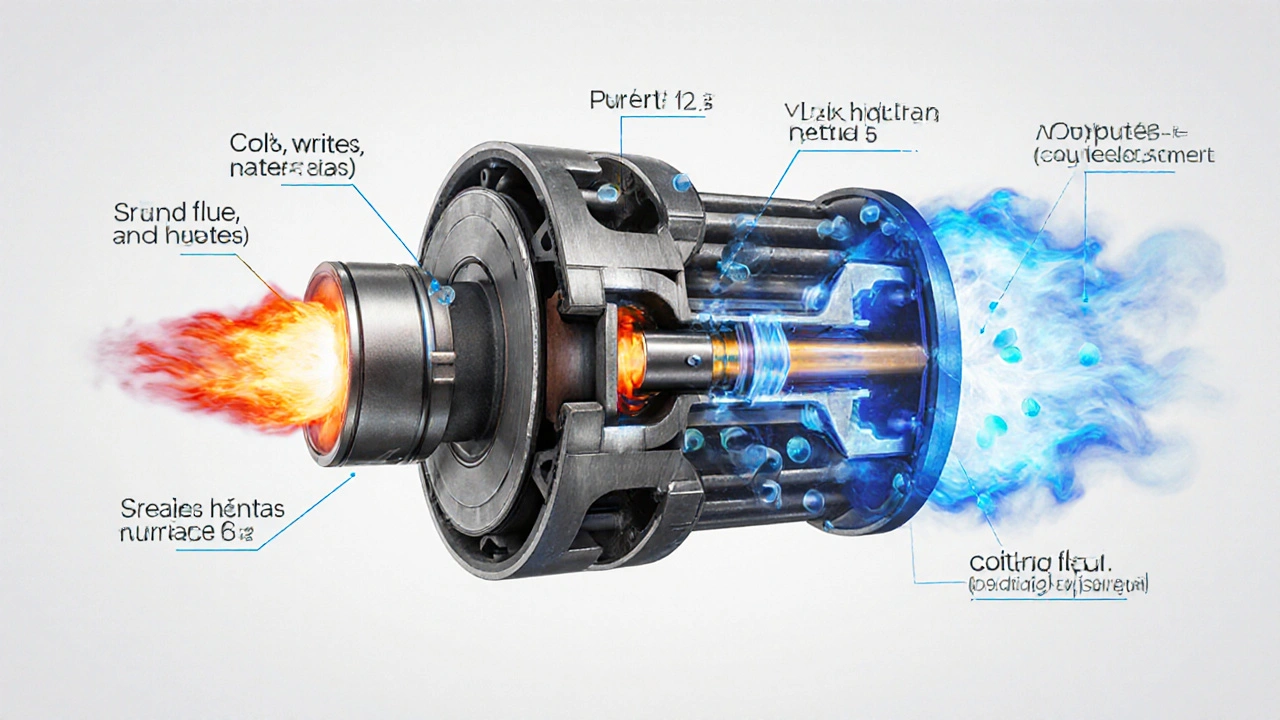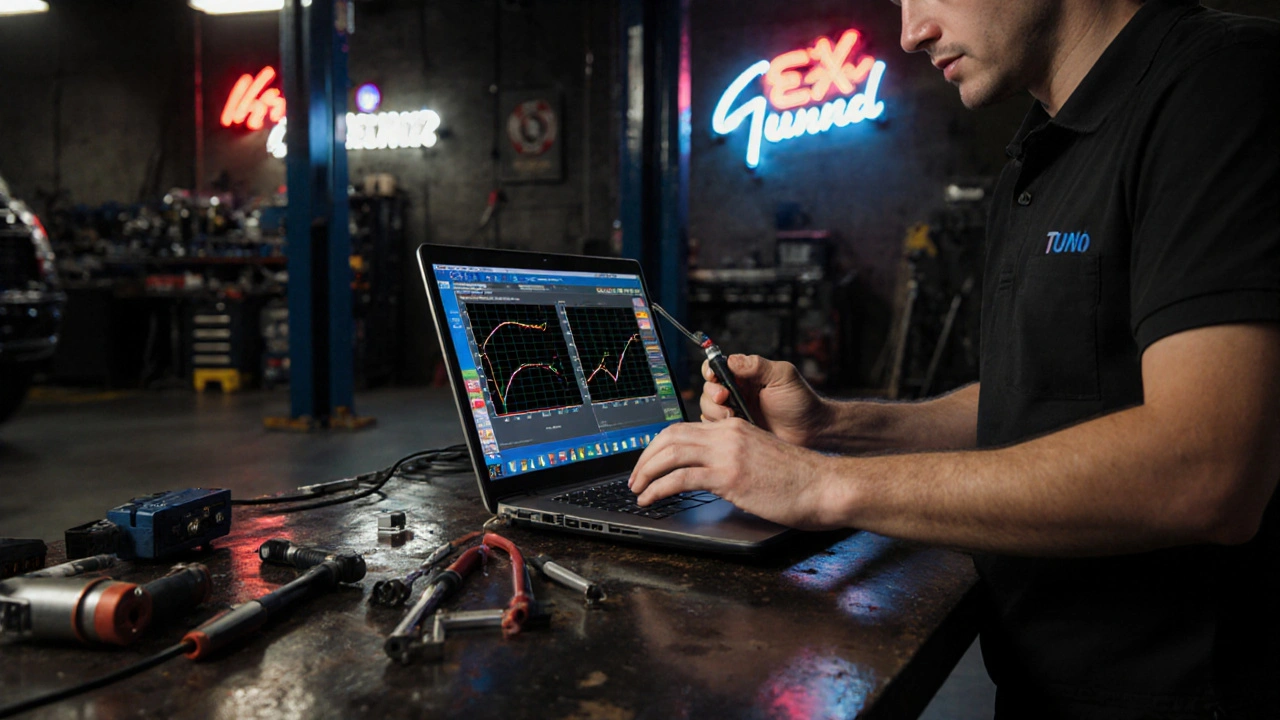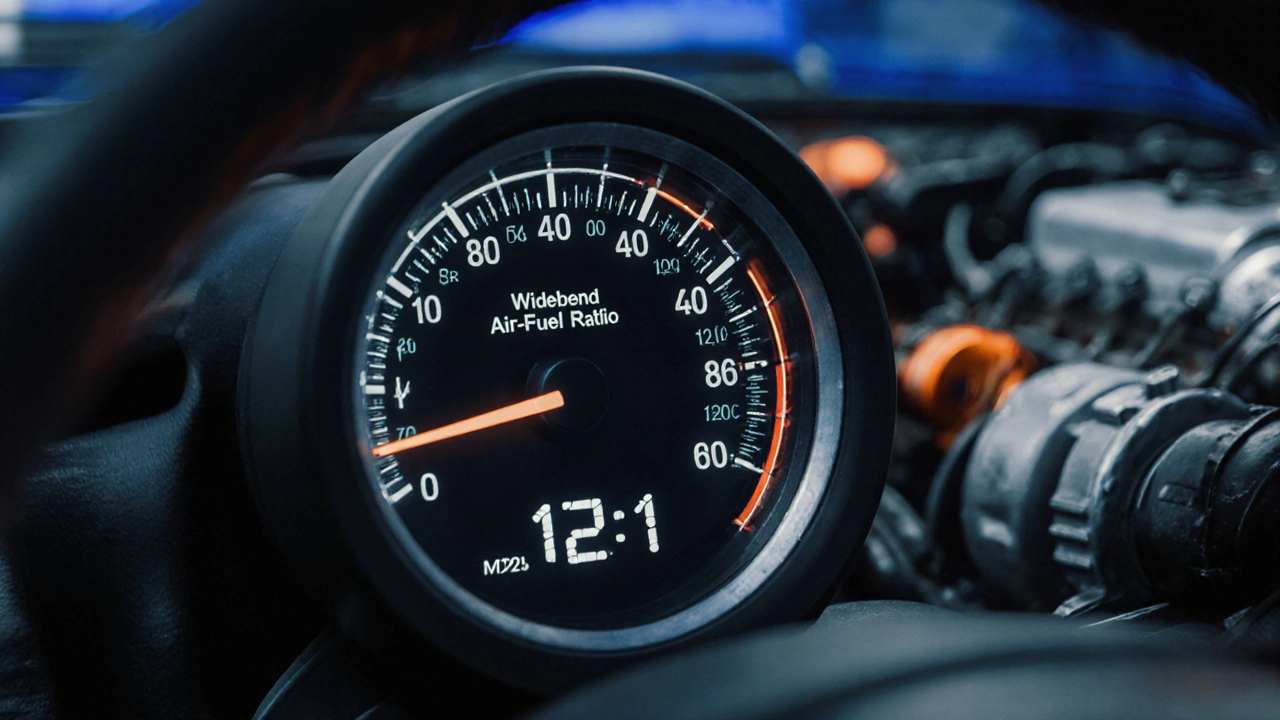The air-fuel ratio is the single most important number in engine tuning. Get it wrong, and you lose power, waste fuel, or kill your engine. Get it right, and you unlock smooth acceleration, better mileage, and longer life. It’s not magic. It’s math. And it’s something every tuner, from weekend hobbyists to professional racers, needs to understand.
What Exactly Is Air-Fuel Ratio?
It’s the mass of air divided by the mass of fuel going into your engine’s combustion chamber. Simple. But the numbers matter. The ideal ratio for complete combustion in gasoline engines is 14.7:1 - that’s 14.7 parts air to 1 part fuel. This is called the stoichiometric ratio. It’s the sweet spot where all the fuel burns with no leftover oxygen or fuel.
But here’s the catch: engines don’t always run at 14.7:1. Different situations need different ratios. Think of it like cooking. Sometimes you want a perfect sear. Sometimes you want slow simmer. Same with engines.
Lean vs Rich: When to Break the Rules
Running lean means more air, less fuel - below 14.7:1. At 15.5:1 or even 16:1, you’re saving fuel. That’s why cruise control and light-load driving often use lean mixtures. But go too lean - say, 17:1 or higher - and your engine starts running hot. You risk melted pistons, cracked valves, and detonation. Lean isn’t always better.
Running rich means more fuel, less air - above 14.7:1. At 12.5:1, you’re cooling the combustion chamber. That’s why race cars and high-performance engines run rich during full throttle. Extra fuel acts like coolant. It prevents knocking and protects internals. But rich mixtures also foul spark plugs, clog catalytic converters, and smell like gasoline. Too much fuel is just as bad as too little.
How Air-Fuel Ratio Affects Power
Maximum power doesn’t happen at 14.7:1. It happens around 12.5:1 to 13.2:1 for most naturally aspirated gasoline engines. Why? Because extra fuel helps pack more energy into the cylinder and cools the charge, letting you run more timing without detonation. Turbocharged engines often run even richer - sometimes as low as 11.5:1 - because they’re under more stress.
Test it yourself. Hook up a wideband O2 sensor to your car. Drive at full throttle in third gear. Watch the air-fuel ratio. Now tweak your fuel map in small 0.2 increments. You’ll see power climb as you go from 14.7 to 13.0, then drop again as you go past 12.0. The peak is your engine’s power sweet spot.

How Air-Fuel Ratio Affects Efficiency
For fuel economy, lean is king - but only if you can control it. Modern cars use closed-loop fuel control at idle and cruise, holding 14.7:1. But advanced systems like GM’s Active Fuel Management or Honda’s VTEC-E shift to lean mixtures (16:1-18:1) during light loads. These systems use precise injector timing and variable valve lift to maintain stable combustion.
However, lean mixtures are unstable. Too lean, and the flame front slows down or misfires. That’s why you can’t just dial in 18:1 everywhere. You need the right combination of ignition timing, cylinder pressure, and airflow to make lean burning work. That’s why factory engines use complex sensors and algorithms. Aftermarket tuners often skip this and just run rich - which wastes fuel.
Tools You Need to Tune Air-Fuel Ratio
You can’t tune what you can’t measure. A stock narrowband O2 sensor only tells you if you’re rich or lean - not by how much. For real tuning, you need a wideband air-fuel ratio meter. Brands like AEM, Innovate, and Bosch give you real-time readings from 10:1 to 20:1.
Pair that with a data logger or ECU tuning software. Log your RPM, load, throttle position, and air-fuel ratio together. Then look at the graph. Are you spiking lean under load? Is your mixture rich at idle? That’s where you make changes.
Don’t just guess. Write down your changes. Change one thing at a time. If you adjust fuel trim and the car runs worse, go back. Tuning isn’t about making big leaps. It’s about small, measured steps.
Real-World Examples: What Works
Take a 2020 Subaru WRX with a stock turbo. Factory tune runs 12.8:1 under full boost. That’s rich - but intentional. The factory engineers know the engine can’t handle lean under high pressure. Swap the turbo for a bigger one, add a cold air intake, and keep the same tune? You’re now running 11.9:1 - dangerously rich. You’ll lose power and risk fouling plugs.
Now take a 1998 Honda Civic with a naturally aspirated B16A engine. Stock tune runs 14.5:1 at wide-open throttle. Tuners often bump it to 13.0:1 for more power. But if you add a high-flow exhaust and camshaft, you might need to go to 12.7:1 to prevent detonation from the increased airflow.
And then there’s the old-school trick: running rich at idle to reduce emissions. Some racers run 13.5:1 at idle to keep the catalytic converter hot and clean. It’s not legal on the street, but it’s common in track cars.

Common Mistakes and How to Avoid Them
- Assuming more fuel = more power. Too much fuel cools the combustion chamber too much, slowing flame speed and reducing power.
- Ignoring temperature. Cold engines need richer mixtures to start. Hot engines need leaner mixtures to avoid detonation. Your tune should adapt.
- Using the same ratio for naturally aspirated and forced induction. Turbo engines need more fuel under boost. Period.
- Not checking for vacuum leaks. A small leak pulls in extra air, making your mixture leaner than your ECU thinks. You’ll think you’re tuned right - but your engine is running leaner than expected.
- Believing the ECU always knows best. Factory tunes are conservative. They protect the engine, not maximize performance.
What Happens When Air-Fuel Ratio Is Wrong?
Lean conditions cause:
- Engine knocking or pinging
- Overheating - especially on exhaust valves
- Misfires under load
- Check engine light with codes like P0171 (System Too Lean)
Rich conditions cause:
- Black smoke from the exhaust
- Fouled spark plugs with wet, sooty deposits
- Reduced fuel economy - sometimes by 20% or more
- Failed emissions tests
- Catalytic converter damage from unburned fuel
Neither is acceptable long-term. One kills your engine. The other kills your wallet.
Final Tips for Better Tuning
- Start with the factory tune as your baseline. Don’t start from zero.
- Use a wideband sensor - not a stock O2 sensor.
- Tune in stages: idle, cruise, part-throttle, full-throttle.
- Check your air-fuel ratio under real driving conditions - not just on a dyno.
- Record your changes. If you don’t write it down, you’ll forget it.
- When in doubt, go slightly rich. It’s safer than going lean.
There’s no universal perfect air-fuel ratio. It depends on your engine, your modifications, your altitude, your fuel, even the weather. The best tuners don’t memorize numbers. They learn how to read the engine’s response. Listen to the knock sensors. Watch the exhaust gas temps. Feel the throttle response. The engine will tell you what it needs - if you know how to listen.
What is the ideal air-fuel ratio for maximum power?
For most naturally aspirated gasoline engines, the ideal air-fuel ratio for maximum power is between 12.5:1 and 13.2:1. Turbocharged engines often run even richer, around 11.5:1 to 12.5:1, to prevent detonation and cool the combustion chamber under high boost.
Can I run a lean air-fuel ratio for better fuel economy?
Yes, but only under light load conditions like cruising or idle. Lean mixtures (15:1 to 18:1) improve fuel economy, but they’re unstable under high load. Running lean at wide-open throttle risks engine damage from overheating and detonation. Modern cars use variable valve timing and precise fuel injection to safely run lean in specific conditions.
Do I need a wideband O2 sensor to tune air-fuel ratio?
Yes. Stock narrowband O2 sensors only tell you if you’re rich or lean - not by how much. A wideband sensor gives you precise readings from 10:1 to 20:1, which is essential for accurate tuning. Without it, you’re guessing.
Why do race cars run richer than street cars?
Extra fuel in a race car cools the combustion chamber and prevents detonation under high cylinder pressure. It also protects valves and pistons from extreme heat. While it wastes fuel, the trade-off is engine reliability and peak power - which is the goal in racing.
What causes a car to run lean after modifications?
Upgrades like larger injectors, high-flow intakes, or bigger turbos increase airflow without increasing fuel delivery. If your ECU doesn’t adjust fuel maps to match, the mixture becomes lean. Vacuum leaks also pull in extra air, creating a false lean condition.
How does altitude affect air-fuel ratio?
At higher altitudes, air is thinner - meaning less oxygen per volume. Your engine still pulls the same amount of air by volume, but it contains less oxygen. This makes your mixture richer than intended. Most modern ECUs compensate automatically, but older or modified cars may need fuel map adjustments.

Diwakar Pandey
November 24, 2025 AT 13:44Been tuning my old Civic for years, and this post nailed it. The 12.5:1 to 13.2:1 range for max power? Spot on. I learned the hard way after blowing a head gasket running 14.5:1 under boost. Now I log everything - RPM, load, AFR - and tweak in 0.1 increments. No more guesswork.
Ajit Kumar
November 25, 2025 AT 09:32It is, without a shadow of a doubt, a fundamental misconception among amateur tuners - and even some professionals - that the stoichiometric ratio of 14.7:1 is the universal benchmark for performance. This is not merely incorrect; it is dangerously misleading. The stoichiometric ratio is a theoretical ideal for emissions control and catalytic converter efficiency, not for power output. In fact, to suggest that one should adhere to it in high-load scenarios is to misunderstand the very physics of combustion. Maximum brake torque occurs when the mixture is deliberately enriched - typically between 12.5:1 and 13.2:1 - because the excess fuel acts as an internal coolant, suppressing knock and allowing for more aggressive ignition timing. To ignore this is to sacrifice performance on the altar of misinformation.
Furthermore, the notion that lean mixtures are inherently ‘efficient’ is equally flawed. Lean burn strategies require precise control of turbulence, combustion chamber geometry, and valve timing - attributes that are rarely present in modified engines. The factory systems that achieve 16:1 or 18:1 under light load utilize multi-point injection, variable valve timing, and advanced knock sensors - none of which are present in most aftermarket setups. To replicate them without these systems is to invite detonation, misfires, and catastrophic engine failure. The data is clear: lean is not a tuning strategy; it is a risk management failure.
And yet, I see forum posts every week where someone says, ‘I ran 15.5:1 on my turbo and got 30 more HP!’ - no, you didn’t. You got lucky once. You got a momentary misfire that fooled your dyno. You didn’t optimize; you endangered. Please, for the love of internal combustion, stop pretending that intuition trumps instrumentation. A wideband sensor isn’t a luxury - it’s a necessity. And if you don’t have one, you’re not tuning - you’re gambling.
Geet Ramchandani
November 26, 2025 AT 14:28Wow. Another ‘tuner’ who thinks they’re a mechanic because they bought a $300 wideband. Let me guess - you also think ‘running rich’ means you can ignore your spark plugs and just blame the fuel pump. Newsflash: if your engine is running 11.5:1 at idle, you’re not a racer - you’re a trash can with wheels. And don’t even get me started on people who say ‘factory tunes are conservative’ like that’s a badge of honor. No, it’s called engineering. Your ‘performance’ mods are just expensive noise with a side of carbon buildup. Go touch grass. Or better yet, go back to your stock ECU and stop pretending you know what you’re doing.
Kayla Ellsworth
November 28, 2025 AT 11:45So let me get this straight - the post is basically saying ‘do what the pros do’ but then listing a bunch of numbers like they’re gospel. Meanwhile, the guy who wrote this probably still uses a laptop from 2012 and thinks ‘logging’ means writing on a napkin. Also, ‘listen to your engine’? Cute. Engines don’t talk. They explode. And then you cry. But hey, at least you got a cool graph.
Soham Dhruv
November 28, 2025 AT 21:36Big fan of this post. I’ve been tuning my 2008 WRX for 4 years now and this is the first time someone explained it without sounding like a textbook. I used to think rich = slow, but now I get why my car pulls harder at 12.8 than 14.0. Also, vacuum leaks are the silent killer - mine was leaking at the PCV valve and I didn’t even know it. Changed it and my AFR went from spiking to 16:1 to steady at 13.2. Game changer. Thanks for the clarity.
Sumit SM
November 29, 2025 AT 12:18Let’s be honest - the real secret isn’t the ratio… it’s the intention. The air-fuel ratio is not a number - it’s a conversation. Between the fuel pump and the piston. Between the sensor and the soul. You don’t tune for power - you tune for harmony. When the engine sings, you know you’ve found it. Not at 12.5:1… not at 14.7:1… but at the moment when the air and the fuel, in perfect balance, whisper: ‘we are one.’
And if you’re still using a wideband? You’re missing the point. The engine doesn’t need a meter - it needs a listener.
Bob Buthune
November 30, 2025 AT 15:13😭 I just spent $1,200 on a new fuel pump and wideband sensor and now I realize I’ve been tuning wrong this whole time… I thought running lean was ‘eco-friendly’… I’m so embarrassed. My car sounded like a dying lawnmower at 17:1… I’m crying right now. I’ve ruined my engine… I don’t even know what to do anymore. 🥲 I just wanted to feel fast… 😭
Jen Deschambeault
December 2, 2025 AT 06:54Don’t let the haters get to you. Tuning is a journey - not a destination. You’re already ahead of 90% of people just by caring enough to learn. Keep logging. Keep learning. You’ve got this.
Pooja Kalra
December 3, 2025 AT 09:49There is a deeper truth here - not in the numbers, but in the silence between them. The engine does not speak in ratios. It speaks in vibration. In heat. In the quiet hum of a cylinder that has finally found its rhythm. To reduce this to a spreadsheet is to misunderstand the sacred dance of combustion. We are not tuning machines. We are tuning ourselves - our patience, our humility, our willingness to listen to something older than us. The stoichiometric ratio is not a target. It is a reminder: that balance is not imposed. It is revealed.